
Photo from wikipedia
Background In-situ hybridization (ISH) is a diagnostic tool in the detection of chromosomal anomalies, which has important implications for diagnosis, classification and prediction of cancer therapy in various diseases. Certain… Click to show full abstract
Background In-situ hybridization (ISH) is a diagnostic tool in the detection of chromosomal anomalies, which has important implications for diagnosis, classification and prediction of cancer therapy in various diseases. Certain thresholds of number of cells showing an aberrant pattern are commonly used to declare a sample as positive for genomic rearrangements. The phenomenon of polyploidy can be misleading in the interpretation of break apart fluorescence in-situ hybridization (FISH). The aim of this study is to investigate the impact of cell size and ploidy on FISH results. Methods In sections of varying thickness of control liver tissue and non-small cell lung cancer cases, nuclear size was measured and the number of MET chromogenic ISH and ALK FISH (liver) or ALK and ROS1 FISH (lung cancer) signals was manually counted and quantified. Results In liver cell nuclei the number of FISH/chromogenic ISH signals increases with nuclear size related to physiological polyploidy and is related to section thickness. In non-small cell lung cancer cases tumour cells with higher ploidy levels and nuclear size have an increased chance of single signals. Furthermore, additional lung cancer samples with borderline ALK FISH results were examined with a commercial kit for rearrangements. No rearrangements could be demonstrated, proving a false positive ALK FISH result. Conclusions In case of polyploidy there is an increased likelihood of false positivity when using break apart FISH probes. Therefore, we state that prescribing one single cut-off in FISH is inappropriate. In polyploidy, the currently proposed cut-off should only be used with caution and the result should be confirmed by an additional technique.
Journal Title: Translational Lung Cancer Research
Year Published: 2023
Link to full text (if available)
Share on Social Media: Sign Up to like & get
recommendations!